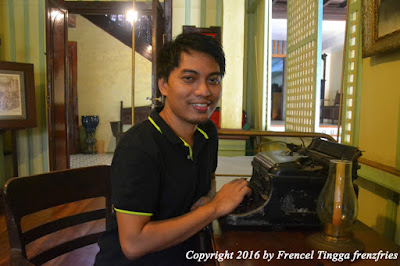“When
I count all the gifts I received in life, I count you twice.”
Had Eulalio
Villavicencio uttered those words to his young bride Gliceria Marella on the
eve of their wedding, I bet she might have swooned with so much kilig. But the Don was more of “man of action”
than “words”. He sealed his promise of forever to the one woman he loved by
giving her a house. Not just any ordinary house but a grandiose, stunningly
beautiful one that was an envy of many.
It was in 1871. And more than a century hence, the house now popularly known as “Casa Regalo de Boda” or “Wedding Gift House” still remains the most gorgeous, most vibrant, and most nostalgic among the two dozen remaining ancestral houses of Taal. I swear.
It was a dream come true to finally spend a night, pretending to be an Ilustrado, in my most favorite traditional Spanish-colonial bahay-na-bato in the historic town of Batangas. The house was built in 1870 and was originally owned by two of the wealthy funders of Philippine Revolution – Don and Doña Villavicencio – both hailed from Taal’s affluent families with businesses in shipping and sugar. The latter is even known as the forgotten heroine in Philippine history. She and her husband strongly supported the Revolutionary Movement, helped disseminate copies of the fiery periodical La Solidaridad to inspire Filipinos to rise up against Spaniards, and donated funds to Rizal in 1892 as their personal tribute to the propaganda movement. For her heroic contributions, she was named “The Godmother of the Revolution” as declared by Emilio Aguinaldo in Kawit, Cavite during the Independence Declaration in 1898.
The house has witnessed not only Spaniard colonization. During the American occupation, it served as a hospital for wounded American soldiers. Though it has survived World War II and natural calamities, the house became derelict. The surviving heirs, particularly Jocelyn “Joyce” Villavicencio Joven-Quiblat (fourth generation of Villavicencios) with the help of her husband, led the house restoration which started in 1998 and lasted until 2003. The house now serves as a museum and a bed and breakfast place.
The entresuelo or ground floor has beautiful intricate patterned Portuguese azulejo tiles.
A guestroom and showroom on the ground floor features some of the vintage collection of the family such as original edition copies of Noli Me Tangere and El Filibusterismo, a Remington typewriter, and a miniature replica of SS Bulusan. The family-owned steam ship was donated by Gliceria to General Emilio Aguinaldo and became the first warship of the Katipunan.
The main wooden staircase is not the typical 13 steps. And I’m not sure if the last step falls under oro, plata or mata.
But it leads to a caida or foyer where the replica twin portraits of the couple (painted by Juan Luna) still seem to guard over the house. The whole upper floor has sunny bright and beautiful interiors – the walls and ceilings are mainly painted yellow and enhanced by curlicues, fleur-de-lis patterns and murals designed by historian Sonny Tinio. They look so warm, playful and whimsical, very pleasing to the eyes.
The design extends to the sala furnished with life-size mirror, chandelier, figurines, tables and art nouveau chairs with carved faces, paintings, lamps and grand piano - a showcase of fine elegance and opulence reminiscent of Victorian era. The living room also has wall-to-wall sliding capiz windows and box like balconies overlooking a courtyard.
The cuarto principal has a charming four-poster bed, a study area and a prayer nook filled with numerous religious figurines and a mesa altar with Virgen del Rosario.
Connecting to it is a smaller but equally exquisite room with enchanting bamboo and butterfly wall design. It is also equipped with an American period toilet. Since it is a wedding house, the room is quite perfect for honeymooners.
A much bigger family room could occupy seven and more.
Staying overnight comes with a hearty Taal breakfast in the comedor. The dining room has a long mahogany table that could fit a family or group of 12. It is usually Ate Raquel, the wonderful caretaker, who personally prepares the rich and thick mainit na tsokolate, and the sumptuous tapang Taal and daing, with rice and eggs.
Ate Joyce also allowed me to cook tapa and longganisa (I bought from Gerry and Lheen), in the adjoining azotea.
From the mirador or viewdeck, one could see the rooftop of the neighboring Casa Villavicencio, the original house of Eulalio when he was still single.
The courtyard has a landscaped garden with a gazebo. But what’s really fascinating are the vines that have find their way to the walls up to the windows, perfectly framing the side house exterior.
I imagine the couple, so young and still in love in a time so uncertain and precarious.
I remember Mark from NHCP telling
me that before Gliceria married Eulalio, she was already promised thru an
arranged marriage to Felipe Agoncillo. She almost gave her heart to someone
else. She almost ended up with someone she didn’t love, and who didn’t love her
in return.
Oh well, when did the course of
true love ever run smooth?
Villavicencio
Wedding Gift House
#32
Calle Gliceria Marella
Taal,
Batangas
Tel.
No.: 0917-8970363







































No comments:
Post a Comment